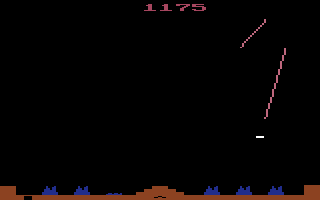 Stuck with only a turret and a prayer, players have the rather disturbing task of preventing nuclear
Armageddon, which is raining down towards six cities. Sending up defensive missiles that stop the deadly firepower, the cities below can only wait for the inevitable. No matter how good you really are, the enemy assault eventually becomes overbearing and the final city will fall.
Stuck with only a turret and a prayer, players have the rather disturbing task of preventing nuclear
Armageddon, which is raining down towards six cities. Sending up defensive missiles that stop the deadly firepower, the cities below can only wait for the inevitable. No matter how good you really are, the enemy assault eventually becomes overbearing and the final city will fall.
But, can you make the call and decide which city should meet their fate? Letting only a single city survive is arguably a wise strategy, providing an easier way to keep the game going. Maybe the farthest cities should be provided with the most cover. What if a missile is barreling down onto the player controller turret? Do you keep yourself alive or risk another city experiencing a doomsday scenario? The entire experience is actually stressful, especially when the pace picks up in later levels.
Translating the game from the arcade brings with it some limitations, including the deletion of two missile silos. In actuality it makes for a better game, since you only have one main base to defend instead of three. Now full concentration remains on protecting the cities, which is really what the game is about, instead of trying to cover more firing posts. It's one of those rare situations where a translation makes a change that improves the game.
 What doesn't change is the games awful look. Invading missiles are nothing more than lines, explosions from the player's defenses are just squares strewn together, and the ground is nothing but a single flat color (which changes from level to level). The only nice touch is the mini-mushroom cloud that spurts from a leveled city. Even the classic game over screen (made famous by the equally classic "Terminator 2") is missing. The same goes for sound, which includes a simple explosion that hardly sound effective considering the rather desperate situation.
What doesn't change is the games awful look. Invading missiles are nothing more than lines, explosions from the player's defenses are just squares strewn together, and the ground is nothing but a single flat color (which changes from level to level). The only nice touch is the mini-mushroom cloud that spurts from a leveled city. Even the classic game over screen (made famous by the equally classic "Terminator 2") is missing. The same goes for sound, which includes a simple explosion that hardly sound effective considering the rather desperate situation.
Without a trackball, the game does lose more than a few turrets in the translation. But, the joystick is arguably more accurate in the end. You'll never overshoot a target, but maybe that's the way it was intended too. Regardless, "Missile Command" is brilliant in just about any form. Finding another title from this era with so many different ways to play is not an easy task and makes this one a unique title amongst a crowded market.